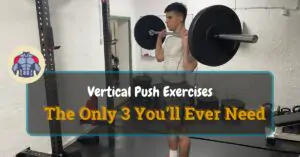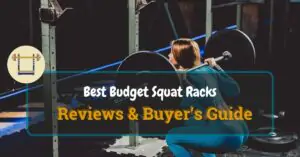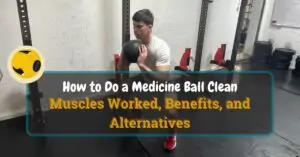The elevated sumo squat is a variation of the traditional sumo squat that allows for a greater range of motion and squat depth.
Table of Contents
ToggleWhy is this important?
Well, it is important because you can intensify your workouts by targeting your adductors and glutes slightly more with the elevated surface.
In this article, you will learn:
- The step-by-step guide to performing elevated sumo squats correctly.
- The differences between elevated sumo squats and traditional sumo squats.
- Tips and common mistakes to watch out for to maximize your workout efficiency.
- The most important elevated sumo squat variations and alternatives.
Let’s start with the guide so you can perform elevated sumo squats without injuries.
Start Building Your Dream Body Today
Ready to elevate your fitness game without falling into the trap of dull, repetitive routines that just don’t deliver? Imagine sculpting your ideal physique and boosting your health, all while still enjoying life’s pleasures, like those irresistible weekend getaways and your aunt’s legendary cheesecake. With our online fitness and nutrition coaching service, you don’t have to compromise. Dive into a personalized fitness journey that blends perfectly with your lifestyle, not against it. Book your completely free discovery consultation today, and take the first step towards a transformation that doesn’t require giving up the joys of life.

“I was skeptical about online fitness coaching, but Functional Body Savage completely changed my perspective. Vanja and Radomir’s personalized approach and attention to detail have helped me achieve goals I never thought possible. I’m stronger, more confident, and grateful for their guidance.”
Emily Thompson, San Francisco, CA
Learn More About Our Online Coaching ServiceQuick Summary
- To perform the elevated sumo squat, stand on a low platform with feet wider than shoulder-width, toes pointed outward, squat down while keeping the chest up, and return to the starting position.
- Key components include choosing a stable platform, maintaining proper foot placement, and engaging core muscles for balance and posture.
- A study from PubMed Central titled “Comprehensive Approach to Core Training in Sports Physical Therapy” highlights the importance of core engagement in optimizing performance and minimizing injuries.
- In my experience, incorporating elevated sumo squats into your workout routine can significantly improve lower body strength, balance, and flexibility, leading to enhanced performance in various physical activities.
How to Do an Elevated Sumo Squat – Step-By-Step Guide
Follow this step-by-step guide to ensure proper form and technique.
Step One — Assume the Starting Position
Begin by selecting a low, stable platform to stand on. This could be a step, a weight plate, or any sturdy, elevated surface that allows your feet to be slightly raised off the ground. Pick the kettlebell of the appropriate size so you can perform at least 8 consecutive reps. Stand on the platform with your feet wider than shoulder-width apart.
Your toes should be pointed outward at about a 45-degree angle, aligning with the natural direction of your knees.
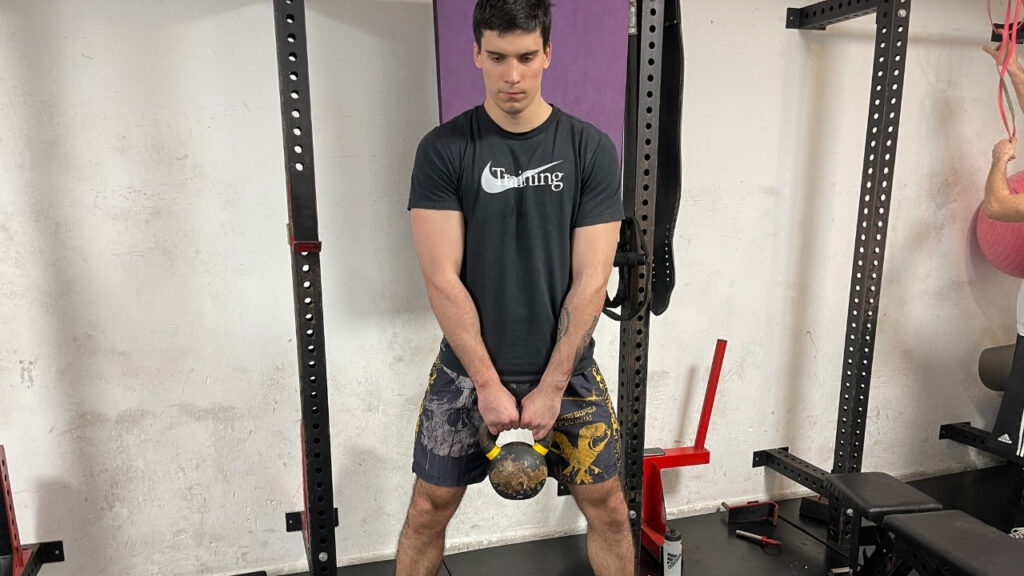
Pro Tip: Experiment with slightly different foot positions to find the angle that feels most natural and allows for the deepest squat without discomfort.
Step Two — Bend and Lower the Weight Down
Keep your core tight and chest up throughout the movement. This will help maintain balance and protect your spine. Slowly bend your knees and lower your hips back and down as if sitting in a chair.
Ensure your knees track over your toes and do not cave inward. Aim to lower yourself until your thighs are at least parallel to the platform, or go deeper if your flexibility allows. The elevated position should enable a greater range of motion compared to a standard sumo squat.
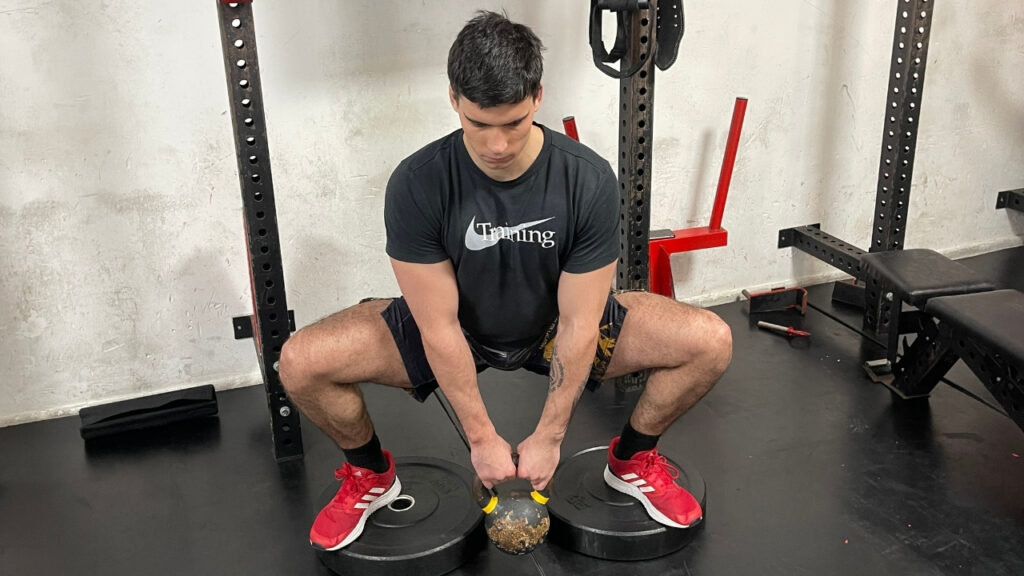
Pro Tip: Imagine you’re trying to sit back into a chair that’s just a bit too far behind you to encourage hip hinge and depth in the squat.
Step Three — Extend Your Ankles, Knees, and Hips
Press through the outer edges of your heels, engaging your glutes and hamstrings to return to the starting position. Ensure your knees remain wide and do not buckle inward. As you ascend, keep your back straight and chest lifted. Avoid rushing the movement and focus on a controlled tempo.
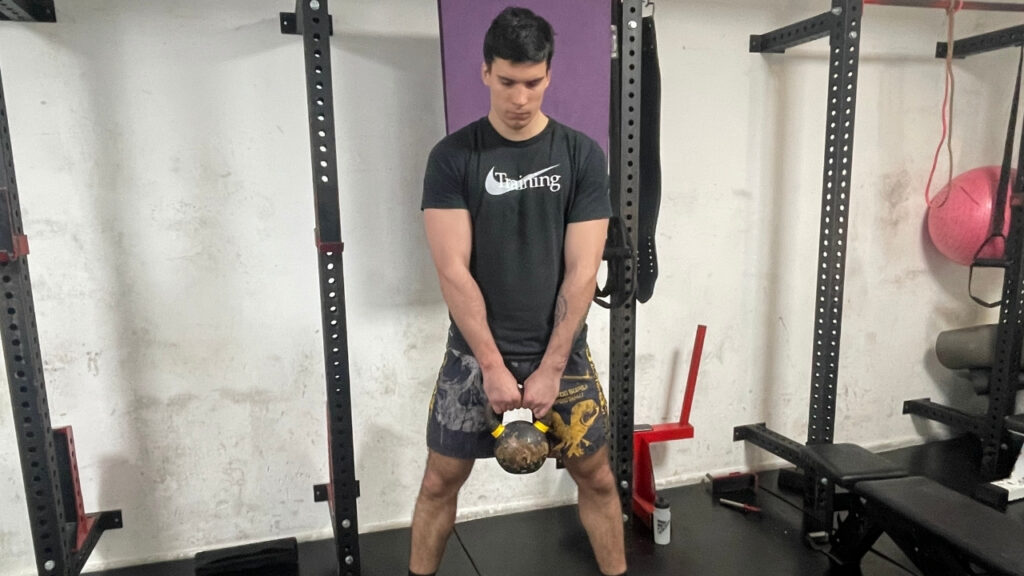
Pro Tip: Focus on engaging your glutes at the top of the movement for an extra contraction, maximizing the exercise’s effectiveness.
Elevated Sumo Squat vs Sumo Squat
While both elevated sumo squats and traditional sumo squats target the lower body muscles, including the glutes, quadriceps, and inner thighs, the elevated version introduces a few key differences that amplify its effectiveness.
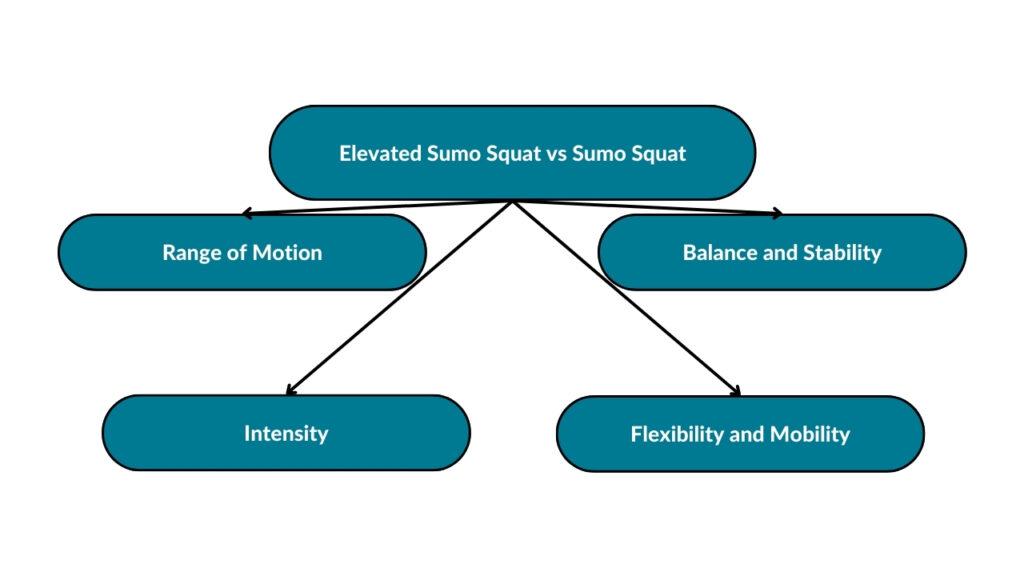
Range of Motion
Elevated sumo squats allow for a greater range of motion compared to traditional sumo squats. The elevated platform enables you to lower your body further, deepening the squat and intensifying the muscle engagement.
Intensity
By increasing the squat depth, elevated sumo squats place more demand on the targeted muscles, particularly the glutes and inner thigh muscles (adductors). This increased intensity can lead to more significant strength gains and muscle development over time.
Balance and Stability
The elevated position challenges your balance and stability more than a traditional sumo squat. This can lead to improvements in core strength and overall balance as your body works to maintain proper form on the elevated surface.
Flexibility and Mobility
The deeper squat achievable with elevation also aids in enhancing flexibility and mobility in the hips and ankles, contributing to better overall joint health and function.
Elevated Sumo Squat Muscles Worked
The primary muscles working are:
- Gluteus maximus
- Quadriceps
- Adductors
Also, the secondary muscles working include:
- Hamstrings
- Core muscles (including abdominals and lower back)
- Calves
Elevated Sumo Squat Benefits
Incorporating elevated sumo squats into your exercise regimen brings forth a multitude of benefits, not just for your lower body strength but for your overall fitness and well-being.
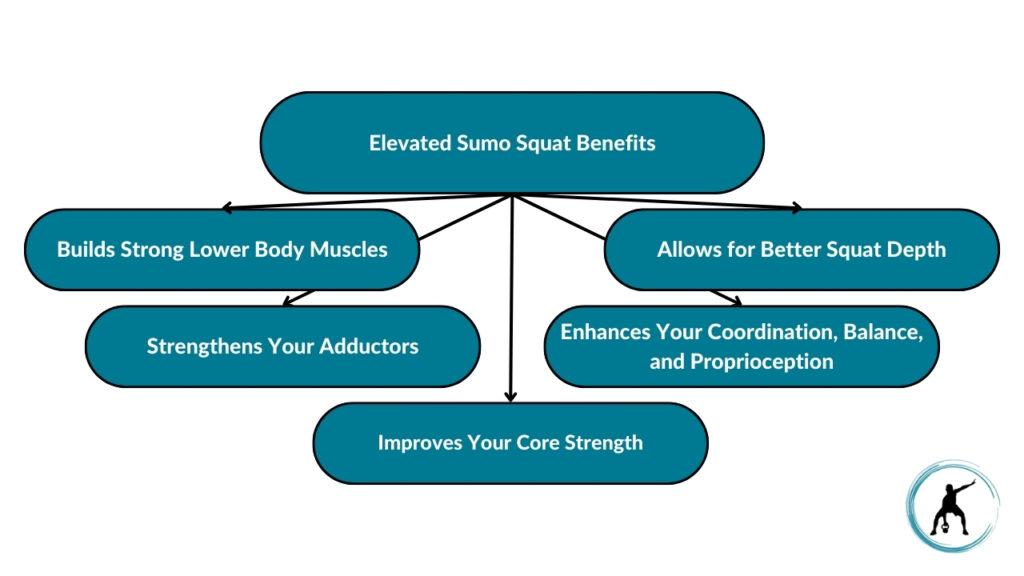
Here’s a deeper dive into the advantages.
Builds Strong Lower Body Muscles
The elevated sumo squat is particularly effective for targeting and enhancing the strength of the lower body’s primary muscle groups. Engaging the glutes, quadriceps, and adductors more intensely than traditional barbell back squats promotes muscle growth and development.
This leads to improved performance in other exercises, sports, and daily activities that rely on lower body strength.
Strengthens Your Adductors
One of the unique benefits of the elevated sumo squat is its emphasis on the adductor muscles. These muscles play a crucial role in leg stability and mobility. Strengthening the adductors can help prevent injuries by supporting the knee joint and improving your ability to perform movements that require lateral motion.
Improves Your Core Strength
Beyond targeting the lower body, elevated sumo squats engage the core muscles, including the abdominals and lower back.
This engagement is critical for maintaining balance and posture on the elevated platform, enhancing core stability and strength. A strong core is foundational for a wide range of exercises and can help protect against back pain and improve posture.
According to a study from the PubMed Central website titled “Comprehensive Approach to Core Training in Sports Physical Therapy: Optimizing Performance and Minimizing Injuries,” the core plays a vital role in providing stability, force transmission, and injury prevention in athletes [1].
Enhances Your Coordination, Balance, and Proprioception
The act of balancing on an elevated surface while performing squat challenges improves your coordination, balance, and proprioception (the body’s ability to sense movement, action, and location).
These skills are vital for athletes and non-athletes alike, contributing to better performance in sports, reducing the risk of falls, and enhancing overall physical coordination.
Allows for Better Squat Depth
Thanks to the elevated stance, this squat variation enables a greater range of motion than is possible on flat ground.
A deeper squat not only increases muscle activation but also works to improve flexibility and mobility in the hips, ankles, and lower back. Enhanced mobility can lead to more efficient movement patterns and a reduced risk of injury in both workouts and daily life.
Tips
Performing elevated sumo squats requires not only the right technique but also an awareness of how to optimize the exercise for safety and effectiveness. Here are some key considerations.
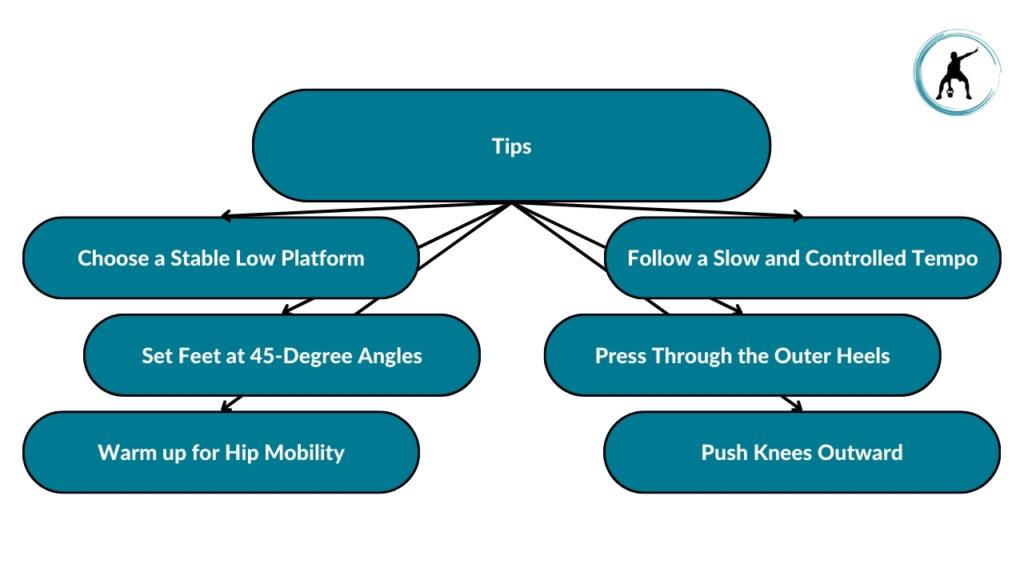
Choose a Stable Low Platform
Ensure the platform you select is sturdy and low, challenging your range of motion without compromising balance or safety. Opting for a too-high platform can lead to injuries, particularly for beginners or those with limited flexibility.
Set Feet at 45-Degree Angles
Proper foot placement activates the right muscle groups and maintains balance. Align your knee movement with your toes by setting your feet at 45-degree angles. This will prevent knee strain and effectively engage the glutes and inner thighs.
Warm up for Hip Mobility
Warm up with exercises that increase hip mobility before attempting elevated sumo squats. Perform dynamic stretches and movements like leg swings and hip circles to prepare for the deeper squat position and minimize injury risks.
Follow a Slow and Controlled Tempo
Maximizing the squat’s effectiveness comes from performing it slowly and with control. Rushing can lead to improper form and less muscle engagement. A deliberate pace allows for focusing on squat depth and muscle activation.
Press Through the Outer Heels
Engage your glutes and hamstrings effectively by pressing through the outer edges of your heels as you return to the starting position. This method provides a stronger lift and better stability.
Push Knees Outward
Engage your adductors and prevent your knees from collapsing inward by actively pushing your knees outward during the squat. This not only engages the correct muscles but also ensures better lower-body muscle activation.
Most Common Mistakes
When it comes to elevated sumo squats, certain mistakes can hinder your progress and increase the risk of injury. Recognizing and correcting these errors is key to maximizing the exercise’s benefits.
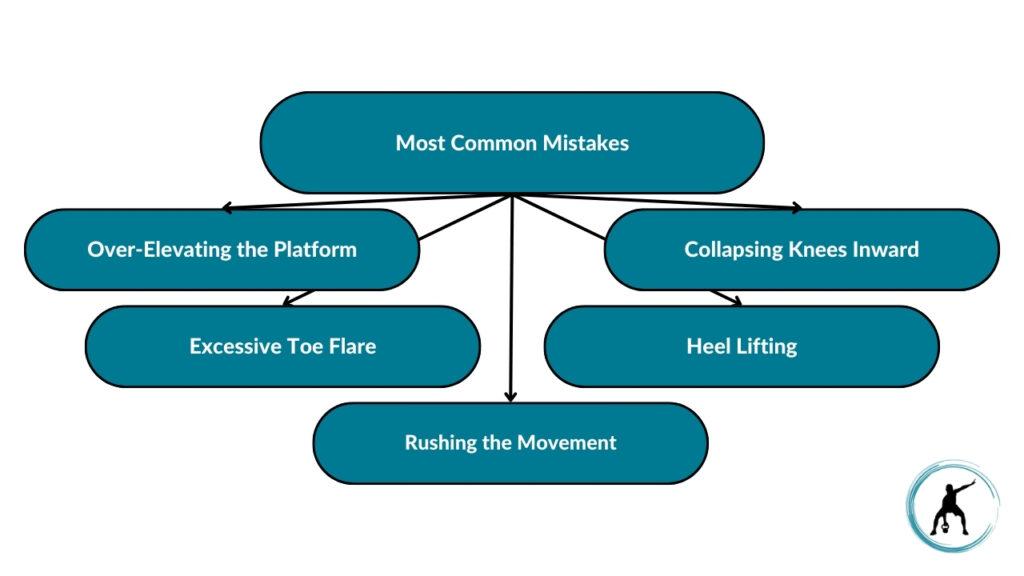
Over-Elevating the Platform
Starting with a platform that’s too high can compromise your form and balance, leading to ineffective muscle engagement or injury. Stick to a height that challenges you without sacrificing stability.
Excessive Toe Flare
While your toes should point outward, overdoing it can strain your knees. Keep your toes at a 45-degree angle to align your knees properly during the squat, ensuring effective muscle activation and reducing injury risk.
Rushing the Movement
Speeding through the squat prevents proper muscle engagement and can lead to sloppy form. Focus on a controlled, deliberate pace to ensure full range of motion and optimal muscle use.
Heel Lifting
Keeping your heels grounded is crucial for stability and force generation. If your heels lift off the platform, it can signal a lack of mobility or improper weight distribution. Focus on pressing through your heels to maintain contact with the platform throughout the exercise.
Collapsing Knees Inward
Allowing your knees to cave in can lead to knee pain and injury. Actively push your knees out to engage your glutes and adductors properly, supporting knee stability and enhancing the exercise’s effectiveness.
Elevated Sumo Squat Alternatives
Here are some of the best alternatives to the elevated sumo squat you can try.
Barbell Sumo Squat
The barbell sumo squat allows for heavier loads to be used, targeting the glutes, quads, and inner thighs effectively.

Steps:
- Stand with your feet wider than shoulder-width apart, toes pointing outward, and a barbell across your upper back.
- Brace your core and keep your chest up as you lower into a squat, pushing your hips back.
- Keep your knees in line with your toes and squat until your thighs are parallel to the ground.
- Drive through your heels to return to the starting position.
- Repeat for the desired number of reps.
Pro Tip: Focus on maintaining a tight core and a neutral spine throughout the movement to prevent injury and ensure proper form.
Goblet Squat
The goblet squat is a beginner-friendly exercise that helps improve squat form and targets the lower body effectively.
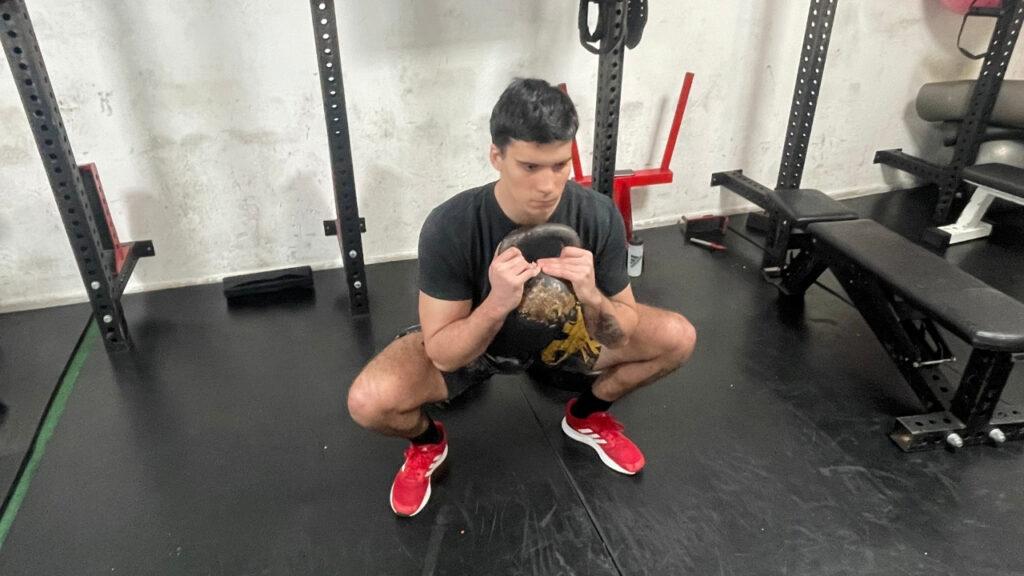
Steps:
- Stand with your feet shoulder-width apart, holding a kettlebell or dumbbell close to your chest.
- Lower into a squat, keeping your elbows between your knees.
- Ensure your chest stays up and your back remains straight.
- Push through your heels to return to the starting position.
- Repeat for the desired number of reps.
Pro Tip: Use the weight as a counterbalance to keep your chest up and enhance the depth of your squat.
Bulgarian Split Squat
The Bulgarian split squat is a unilateral exercise that isolates one leg at a time, improving balance and addressing muscle imbalances.

Steps:
- Stand about two feet in front of a bench or elevated surface and place one foot behind you on the bench.
- Lower your body by bending your front knee and keeping your torso upright.
- Lower until your front thigh is parallel to the ground.
- Push through your front heel to return to the starting position.
- Repeat for the desired number of reps before switching legs.
Pro Tip: Keep your front knee in line with your toes and avoid letting it collapse inward to prevent knee strain and ensure proper muscle engagement.
FAQs
Is Sumo Squat Better Than Squat?
The sumo squat is not necessarily better than the traditional squat; it is a variation that targets different muscle groups. The sumo squat focuses more on the inner thighs, glutes, and hips, while the traditional squat targets the quads, hamstrings, and lower back.
How Many Sumo Squats Should I Do a Day?
The number of sumo squats you should do a day depends on your fitness level and goals. For general fitness, performing 3 sets of 10-15 reps as part of a lower-body workout is a good starting point.
How Many Sumo Squats Should a Beginner Do?
A beginner should start with 2-3 sets of 8-12 sumo squats per set. It’s important to focus on proper form and gradually increase the number of reps as strength and endurance improve.
Should I Go Heavy on Sumo Squats?
Whether you should go heavy on sumo squats depends on your fitness level and goals. If you’re aiming for strength and muscle growth, gradually increasing the weight while maintaining proper form is beneficial.
Are Sumo Squats Better for Knees?
Sumo squats can be better for the knees for some individuals, as the wider stance and outward toe position may reduce stress on the knee joints. However, it’s important to listen to your body and modify the exercise if you experience any discomfort.
How Long Should You Hold a Sumo Squat?
The duration of holding a sumo squat depends on your fitness goals. For isometric strength and endurance, holding the squat for 20-30 seconds or longer can be effective.
Are Sumo Squats More Quads or Hamstrings?
Sumo squats target more of the inner thighs and glutes, with secondary engagement of the quads and hamstrings. The wide stance shifts the focus away from the quads and more towards the posterior chain muscles.
Wrapping Up
The elevated sumo squat is an effective exercise for targeting the lower body, particularly the glutes, adductors, and quads. Also, incorporating elevated sumo squats into your workout routine can enhance your overall strength, balance, and flexibility.
This leads to improved performance in various physical activities and even real-life scenarios. In the comments below, let me know your thoughts on elevated sumo squats and how you implement them in your workout routine.
Start Building Your Dream Body Today
Ready to elevate your fitness game without falling into the trap of dull, repetitive routines that just don’t deliver? Imagine sculpting your ideal physique and boosting your health, all while still enjoying life’s pleasures, like those irresistible weekend getaways and your aunt’s legendary cheesecake. With our online fitness and nutrition coaching service, you don’t have to compromise. Dive into a personalized fitness journey that blends perfectly with your lifestyle, not against it. Book your completely free discovery consultation today, and take the first step towards a transformation that doesn’t require giving up the joys of life.

“I was skeptical about online fitness coaching, but Functional Body Savage completely changed my perspective. Vanja and Radomir’s personalized approach and attention to detail have helped me achieve goals I never thought possible. I’m stronger, more confident, and grateful for their guidance.”
Emily Thompson, San Francisco, CA
Learn More About Our Online Coaching ServiceReferences:
- Lupowitz LG. Comprehensive Approach to Core Training in Sports Physical Therapy: Optimizing Performance and Minimizing Injuries. Int J Sports Phys Ther. 2023;18(4):800-806. Published 2023 Aug 2. doi:10.26603/001c.84525


